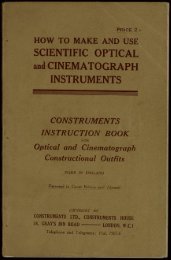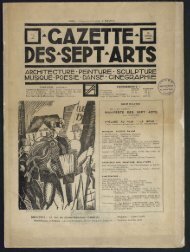Untitled
Untitled
Untitled
You also want an ePaper? Increase the reach of your titles
YUMPU automatically turns print PDFs into web optimized ePapers that Google loves.
64<br />
MODERN MAGIC LANTERNS.<br />
The function of the objective can be seen from Fig. 53A,<br />
where the paths of three of the rays from the lowest part<br />
of the slide only are shown, to avoid confusion, coming to a<br />
focus on the screen at G. With many lenses the rays which<br />
pass through the centre of the slide would not under such<br />
circumstances come to a focus also upon the screen, but at<br />
some point further off than it, say at FL The further the<br />
rays from the centre, the nearer to the lantern would be the<br />
point at which they will come to a focus; in fact, to obtain a perfectly<br />
sharp picture with such a lens, the screen itself would<br />
have to be concave, like the inside of a saucer. Such a lens<br />
would be said to have a curved field, and a lens free from<br />
this defect a flat field. In selecting a lens for use in the<br />
lantern it should always be tried in the lantern itself, and a<br />
4<br />
111111111-<br />
Fig. A. DIAGRAM TO ILLUSTRATE THE FUNCTION OF THE OBJECTIVE.<br />
slide should be used of such a kind as to give a good idea<br />
of the defining power of the lens or its capability of reproducing<br />
on the screen the details of the slide with sharpness.<br />
As good a test slide as any for the purpose is made<br />
by enclosing a piece of open muslin or fine net between a<br />
couple of glasses 31 by 31 and binding it up like an ordinary<br />
lantern slide. Such a subject put in the carrier and<br />
focussed as sharply as possible will give an excellent idea of<br />
the powers of the objective.<br />
Another matter of great importance is the focal length of<br />
the objective, since upon this depends the position of the<br />
THE OPTICAL SYSTEM. 65<br />
lantern and screen for a given size of disc. Perhaps the most<br />
useful length is 6 in., which has the advantage of being that<br />
of a large number of the portrait lenses which are so suitable<br />
for the purpose. The effect of the focal length of the lens<br />
on the size of the disc is best expressed by saying that, with the<br />
lantern and screen in any one position, the shorter the focus of<br />
the objective the bigger the disc, and vice versa, the difference<br />
in diameter being in exact proportion to their focus ; thus a<br />
lens of 12-in, focus gives a disc just half the size of that<br />
obtained with a lens of 6-in, focus at the same distance.<br />
It follows, of course, from this that to obtain always the<br />
same size of disc on the screen, the further the lantern is<br />
from the screen the longer the focus of the lens necessary.<br />
The 12-in, lens above mentioned would give, with a distance<br />
of 24 feet between the lantern and screen, a disc the same<br />
size as would be obtained with the 6-in, objective at 12 feet<br />
distance.<br />
To ascertain the focus of a lens in inches required to<br />
get a given size of disc at a given distance off, the<br />
distance in feet must be multiplied by three* and divided<br />
by the diameter of the disc in feet. ThusWhat lens is<br />
required to give a 15-ft. disc at a distance of 40 feet ?<br />
Multiplying 40 by 3 we get 120, which, divided by 15<br />
gives us 8. The lens, required is therefore one of 8-in.<br />
focus.<br />
This rule may be reversed to find out the size of disc which<br />
would be obtainedthat is to say, by multiplying the distance<br />
in feet by 3* and dividing by the focus of the lens in inches.<br />
For example : we have a6-in. lens, how large will the disc be<br />
at a distance of 50 feet Multiplying 50 by 3 we get 150,<br />
and dividing by 6 the result tells us the disc will be 25 feet in<br />
diameter.<br />
In the same way, to discover the distance at which the<br />
lantern must be placed to give a disc of a given size with a<br />
given lens, the diameter of the disc in feet is multiplied by<br />
the focus of the lens in inches and divided by three.* We<br />
need hardly give another example.<br />
"Three is taken as the effective diameter of the ordinary slide. If slides<br />
are used of any other size the diameter of their opening in inches must be<br />
substituted for " three "in the calculations.

















